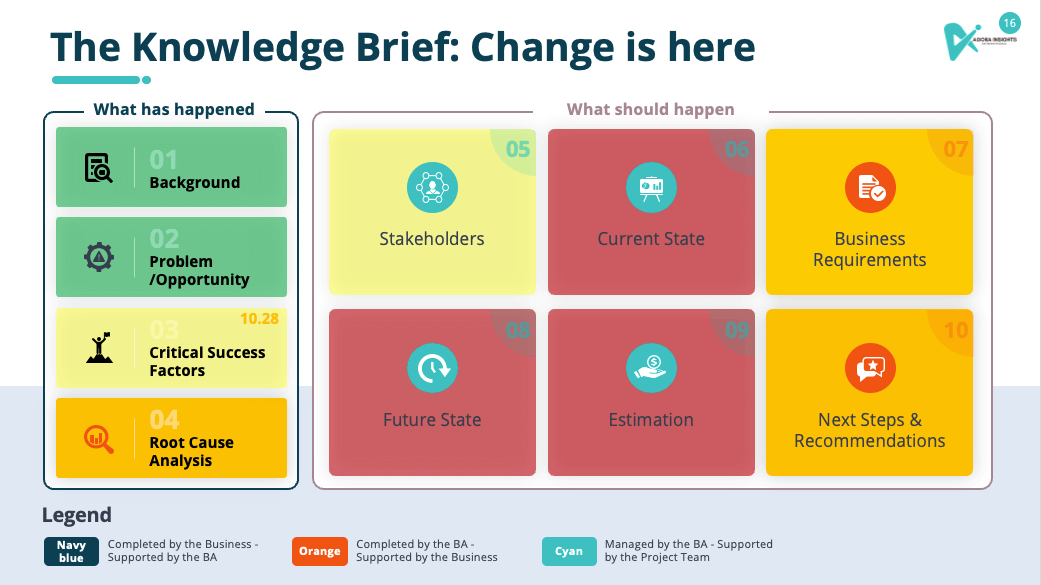Recommendations - As a business analyst, providing excellent recommendations is one of the most effective ways to make a difference in a project. The knowledge you acquire from Parts 1 to 9 of The Knowledge Brief is crucial to build a case and help make sound recommendations to stakeholders. If you want to influence the business direction in a project, you must be prepared to make informed recommendations.
Let's take a look at what we've covered so far and how to structure your recommendations to make a significant impact on the project.
Overview of Part 10 - The Knowledge Brief
Throughout the process of collecting information and converting it into knowledge, the business analyst learns how to ensure that the information provided is fit for purpose, clear, and can be presented effectively, ensuring stakeholders understand the change. This process involves analysis, stakeholder engagement, problem-solving, and other competencies.
The goal is to bring the analyst back into business analysis, enabling them to understand the business's nuances, becoming the conduit of information for stakeholders. Without the hard work required in parts 1 - 9, recommendations are fruitless and rely on assumptions and perception rather than actual analytical efforts.
Even though the steps in The Knowledge Brief are iterative, we still want to understand at what point we land. As we reach part 10 of The Knowledge Brief, we summarize all the information while still storing it in a repository, presenting the key aspects of what needs to be done and why. We understand who needs the insight, when they need it, and why they need it.
How do you add value?
Optimize Resources
Your recommendations can help ensure project resources, such as time, money, and personnel, are utilized effectively and efficiently. Identify the most cost-effective solutions, minimize the project's timeline, and ensure the team is working at maximum capacity.
Align with Business Goals
Your recommendations should align with the company's strategic direction. By doing so, you can increase the project's chances of delivering real value to the organization. Align the project with the company's long-term objectives, enhance its competitiveness, and meet the customers' needs.
Mitigate Risks
Your analysis can help identify potential risks and recommend ways to minimize negative consequences. Provide stakeholders with a clear understanding of the risks associated with each option, helping them make informed decisions that minimize the risk of project failure.
Improve Decision-making
Your recommendations can present stakeholders with options they may not have considered before. Provide thorough analysis and data-backed recommendations, giving stakeholders a clear understanding of the trade-offs associated with each option. This will help stakeholders make informed decisions that align with the business goals of the organization.
Ensure Stakeholder Engagement
Finally, your recommendations can ensure that stakeholders are fully engaged in the decision-making process. By involving stakeholders and giving them a clear understanding of the options available, you'll increase stakeholder buy-in and support for the project. This will help ensure that the project is completed on time, within budget, and to the desired quality standards.
Building a business case
In order for a salesperson to make a successful business case, they must have a well-informed understanding of the company and be introspective about why someone would want to use their product or service, according to Clint Babcock. I found that this video aligned with the idea that a business analyst, as the conduit of information, can pertaining help all kinds of business team, including the sales teams.
The activities conducted by the business analyst in The Knowledge Brief can significantly benefit a business case by providing a well-informed and thoroughly analyzed recommendation for a course of action. A business case aims to justify a particular course of action based on the benefits to be realized by using the proposed solution, as compared to the cost, effort, and other considerations to acquire and live with that solution.
The Knowledge Brief is a process that involves collecting and converting information into knowledge. This knowledge includes analysis, stakeholder engagement, problem-solving, and other competencies that provide a solid foundation for a business case. The business analyst's role in The Knowledge Brief is to ensure that the information provided is fit for purpose, clear, and can be presented effectively to stakeholders.
The activities in The Knowledge Brief can benefit a business case in the following ways:
Define the Need
The business analyst's understanding of the business and its processes can help define the need for change. This information was obtained in parts 1 - 7 of The Knowledge Brief. By identifying pain points, gaps, and opportunities, the business analyst can provide a clear understanding of why the change is necessary.
Determine the Desired Outcomes
The business analyst's thorough analysis of the information collected can help determine the desired outcomes of the proposed solution as presented in part 8 and 9 of The Knowledge Brief. By identifying key performance indicators, success criteria, and goals early, the business analyst can ensure that the proposed solution aligns with the company's long-term objectives.
Assess Constraints, Assumptions, and Risks
The business analyst's analysis from part 6 & 8 of The Knowledge Brief, can help identify potential constraints, assumptions, and risks associated with the proposed solution. By providing stakeholders with a clear understanding of the potential risks and constraints, the business analyst can help stakeholders make informed decisions that minimize the risk of project failure.
Recommend a Solution
Not only can the business analyst make their own recommendations which will ultimately support project but teams can use these recommendations to make their own recommendations. The business analyst's analysis and understanding of the business can help recommend a solution that aligns with the company's strategic direction, mitigates risks, and maximizes the use of resources. By providing stakeholders with a well-informed and thoroughly analyzed recommendation, the business analyst can help justify the proposed solution and increase the chances of delivering real value to the organization.
Conclusion
As a business analyst, you play a critical role in ensuring the success of the project. By using the knowledge you've gained from Parts 1 to 9 of The Knowledge Brief, you can provide clear recommendations to stakeholders based on thorough analysis. This will help optimize resources, align with business goals, mitigate risks, improve decision-making, and ensure stakeholder engagement.
How good are you at delivering recommendations to your organisation? Do they listen to you? And if not, why?
Check out The Knowledge Brief Course:
The Knowledge Brief covers the ten key steps every business analyst should follow in any change project. We take a hands-on approach to what a business analyst should do and how to using multiple tools including Artificial Intelligence ChatGPT.
Post sponsored by Agora Insights Ltd





Post a Comment